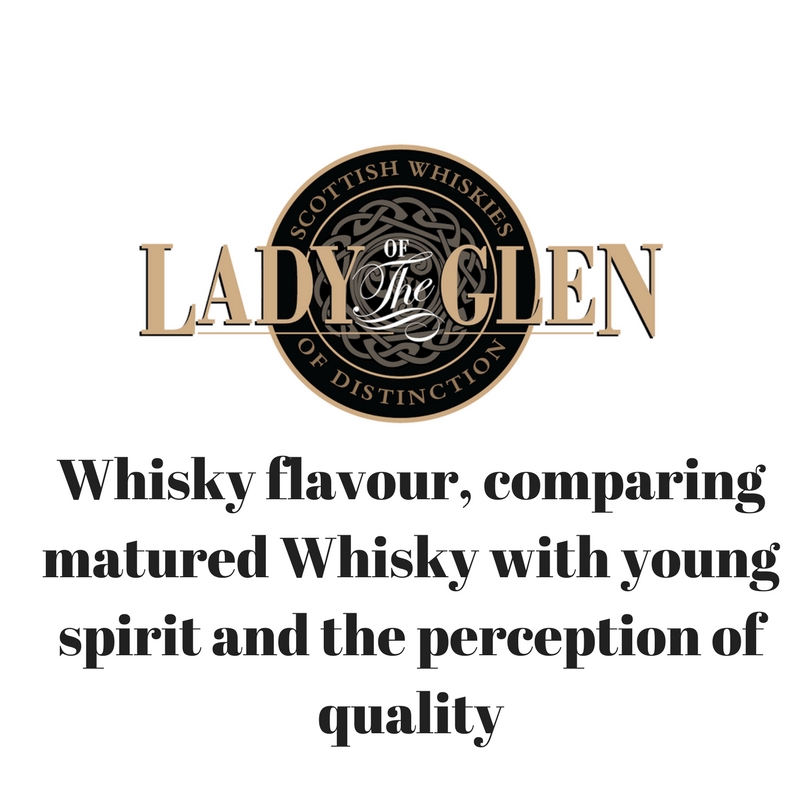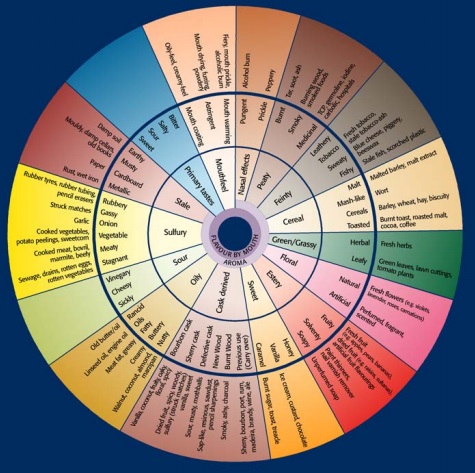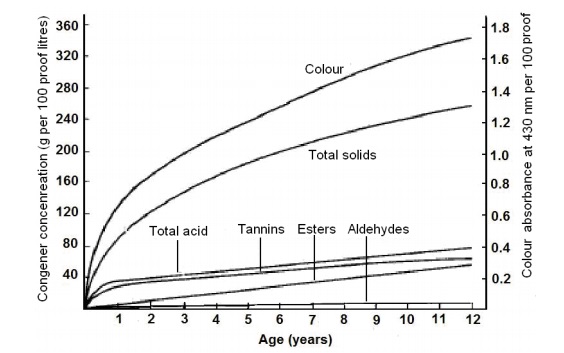Whisky Flavour Comparing Matured Whisky With Young Spirit And The Perception Of Quality Part 2

Part 2 on the development of Whisky flavour
3. Sensory
4. Production and flavour development
4.1 Kilning
4.2 Fermentation
4.3 Distillation
5. New Spirit
6. Maturation
6.1 Variables
6.2 Oak
7. Future research
8. Conclusion
9. References
3. Sensory
Whisky can be analysed in a variety of ways and methods that include microbiology analysis, freezing point analysis, spirit analysis, chemical analysis and sensory analysis(Pryde, Conner et al., 2011). Sensory analysis involves profiling the Whisky flavour (Pryde et al., 2011) and typically it is conducted by a panel (Yoshida et al., 2012) although it can involve just one person (Tao, 2016). There are a variety of aids to assist assessors, such as Quantitative Descriptive Analysis(Stone, 1993), which gives assessors the freedom to express flavours they pick out or the SWRI whisky flavour wheel(Lee, Paterson et al., 2001) which provides a wheel of flavours to help assessors formulate the vocabulary to describe what they taste.

Figure 2. SWRI whisky flavour wheel.(Lee et al., 2001).
The Whisky flavour wheel that provides guidance on the vocabulary when trying to express or identify certain flavours.
Alternatively, assessors could be left to assess flavours on their own as experts(McGrew & Chambers, 2011) or without guidance. The wheel does have practical use, when Mackinlay’s Rare Highland Malt was discovered in 2011 the SWRI whisky flavour wheel was used to identify all the flavours in the Whisky and then an expert tasting panel assessed the flavours on a scale(Pryde et al., 2011). Sensory tasting that involves physical tasting has been labelled organoleptic testing as its qualitative and subjective based (McGrew & Chambers, 2011). McGrew and Chambers (2011) identified multiple weaknesses with sensory analysis, high alcohol can desensitise the nose and palate of the assessor, they can miss off notes when samples are not diluted and they can fail to identify delicate flavour notes in matured products if products are diluted, variations in serving ware and temperature during tasting can impact the analysis and the order in which samples are evaluated can lead to distortions in sampling.
From a Quality Control Perspective Sensory Evaluation is key and involves greater attention to details such as methodological assessor training, sample preparation and recording and reporting steps, that are useful to the scientific evaluation of products (McGrew & Chambers, 2011). Where descriptive analysis methods posses more of the qualities associated with quality control, they have the advantage of being better at predicting how well the consumer will accept the product (Rousseau, 2010). A more constructive sensory can be achieved when descriptive analysis methods possess more of the qualities associated with Quality Control and Sensory Analysis Evaluation because sensory panels have the unique advantage of being better at predicting how well the consumer will accept the product (Rousseau, 2010).
More common are the use of analytical instruments such as the electric nose and electric tongue (Yoshida et al., 2012) which have been used to analyse alcoholic beverages,(Ragazzo-Sanchez, Chalier et al., 2008), beer(Li, Pickard et al., 2007) and wines (Berna, Trowell et al., 2009) for sensory analysis. In a recent study that used a sensory panel and analytical instruments, complimentary results were revealed when used together although the electronic nose was not able to replicate some of the panel’s results on certain notes (Yoshida et al., 2012).
Analytical instruments such as chemical analysis can relate results back ultra-fast and they can be relatively cheap (Yoshida et al., 2012). Congeners which include the alcohol, acids, esters carbonyl compounds, phenols, hydrocarbons, and trace amounts of nitrogen and sulphur containing compounds (Swan & S., 1981) are identified by tools such as gas chromatography(AOAC, 2000, Aylott, 2003). As congeners contribute to sensory character (Tao, 2016) being able to identify them helps to build a picture of aromas and characters of the Whisky(Lee et al., 2001). In addition, direct-injection reversed phase gradient HPLC with fluorescent detection (Aylott, 2003) can be used to detect phenols which again give an idea of Scotch flavours. However, Tao (2016) notes that chemical analysis is not enough on its own; sensory based on qualitative information in conjunction with analytical chemistry provides the strongest assessment of sensory impact. Indeed improved congener analysis has not improved understanding of Whisky flavour which was part of the inspiration behind the SWRI flavour wheel(Monica Lee, Paterson et al., 2001).
4. Production and flavour development
During production Whisky aroma is developed from many different volatile organic compounds(Lee et al., 2001). Some of these will only be obvious in a new spirit as they slip away during further maturation, while other notes remain the same or are only slightly changed during maturation.
4.1 Kilning
Kilning is a major part of flavour development (Tao, 2016), aromas come from Enzymatic and chemical oxidation, Maillard reaction and Peating (Tao, 2016). Enzymes can produce the grainy or green cereal-type odors (Tressl, Bahri et al., 1983). Maillard reaction produces aroma compounds associated with cooked cereal, corn-like and bready aromas (Paterson & Piggott, 1989). Peating, provides that distinct flavour recognizable in Whisky(Bathgate & Cook, 1989), phenolic compounds are the most distinctive compounds of peated malt and in addition peat has been known to contribute over 80 different aromas (Deki & Yoshimura, 1974).
4.2 Fermentation
Lehtonen and Jounela-Eriksson (1983) noted that Fermentation is a key stage in the formation of aromas(Lehtonen, 1983). Aromas are derived from higher alcohols, fatty acids and esters (Tao, 2016) which can tracked to the end product. It is usually the same aromas that are developed at this stage because the same components are used and yeast generally produces the same aromas irrespective of sugar source(Suomalainen & Lehtonen, 1976). The higher alcohols contribute little to aroma with the exception of 2-phenylethanol which produces a rose-like fragrant floral odor (Nykänen & Suomalainen, 1983). Esters provide the greatest influence on aroma (Tao, 2016); the light and medium fractions of the esters provide the ‘fruit esters’(Suomalainen & Nykanent, 1970) and the heavy fraction provides the waxy and oily like aroma (Christoph & Bauer-Christoph, 2007).
4.3 Distillation
Distillation is the basis of production for creating high alcohol beverages (Tao, 2016) and the copper contact of the stills play an important role in the affect of aroma(Lea & Piggott, 2003). Variations in new spirit flavour is believed to come from the unique shapes of the different distillery stills from the swan neck, lyne arm and the affect of the degree of reflux (Nicol, 1989, Nicol, 2003). Tao (2016) noted that distillation will both recover volatile aromas from the fermented wort and stimulate further aroma relevant reactions through the distillation temperatures. The copper reduces sulfur compounds (Harrison, Fagnen et al., 2011, Nicol, 2003) that contain undesirable aromas which are vegetable, rotten egg, grassy or rubbery(Harrison et al., 2011) although it should be noted that a small amount of Sulphur is desirable (Harrison et al., 2011). Therefore, the amount of copper contact from the different still designs plays an important role; the more copper contact the less risk from Sulphur and vice versa. Without copper contact at distillation, spirit distilled was found to taste more unclean (Harrison et al., 2011) which would perhaps make for a more challenging maturation to eradicate off notes.
5. The new spirit
Following the end of distillation new spirit is produced. New spirit(Conner et al., 2003) has been described as pungent, (with) unpleasant odors and sharp tastes. Unfortunately, it can be produced with many immediate issues that cause off notes related to ethanolic pungency caused by ethanolic content(Withers, Piggot et al., 1996), peppery off notes caused by bacteria(Kahn, La Roe et al., 1968), fermentations that produce acrolein, (Kahn et al., 1968) elevated temperatures or extended fermentations caused by yeast catabolism(Sponholz, 1993), pungent burnt and peppery notes caused by acrolein in distillation(Hardy & Brown, 1989), bacterial contamination in the washback, agitations in pH, oxygen tension(Mills, Baugh et al., 1954). However, after 2-3 years of maturation traces of these issues will disappear(Lee et al., 2001) which would suggest longer maturation is desired in order to be assured of the removal of possible off-notes. Arguably maturation through aging is described as the most important and costly stage of distilled beverage production(Mosedale & Puech, 1998) in comparison to distillation and other stages.
6. Maturation
Beyond the minimum three years that Whisky needs to be matured in oak(Mosedale & Puech, 1998), there is little knowledge of the relationship between maturation time and the quality of the final product (Tao, 2016). In many respects time is relative to other variables.
6.1. Variables
A whisky’s storage parameters (Philp, 1989) can vary wood extraction as humidity and temperature play a role in extraction; whisky matured in colder climates will have slower wood extraction (Tao, 2016) and therefore longer maturation is required.
New make spirit characteristics, spirits that have higher alcohol levels will extract flavour from the wood quicker(McGrew & Chambers, 2011) which would mean higher alcohol new make spirit could have hastened maturation.
The size of the cask will impact the extraction. Products in smaller barrels will gain more wood character quicker due to greater levels of wood contact (McGrew & Chambers, 2011) which means spirits can be overpowered by wood quicker while extraction is quicker.
As the role of oak makes up a number of these variables, it is obviously a key part of maturation and has noted as such(Lee et al., 2001).
6.2 Oak
Oak maturation is fundamental to the production of Whisky – maturing in oak will reduce the notes that are pungent, soapy, sour and harsh and encourages smoothness, maturity and mellowness in new spirit (Lee et al., 2001). It is understood to be essential in improving fresh distillate (Tao, 2016) and to remove immature character, in particular it removes sulphur compounds(Philp, 1986). Oak’s ability to extract and transform volatile compounds is of prime importance to the final aroma (Tao, 2016). Oak will infuse unique aromas too, such as clove like flavours (Mosedale & Puech, 1998).
Compounds such as tannins, organic acids, sugars, as well as glycerol are extracted from the wood into the Whisky rapidly within the first 6 months, followed by a slow linear increase with time (Mosedale & Puech, 1998, Nishimura & Matsuyama, 1989) see Figure 3 for wood extraction. Colour is also added (Mosedale & Puech, 1998) which acts as an indication of quality too.

Figure 3. Congener changes over time (Nishimura & Matsuyama, 1989)
The colour of Whisky increasing over the years of maturation
The choice of wood would appear to have a strong influence on the character and aroma of Whisky. First fill-oak casks have rapid initial wood extract extraction within the first 6 to 12 months whereas refill casks have comparably less extraction over the same period (Tao, 2016) and as overall extraction is lower this which implies weaker cask characteristics related to woody vanilla and sweet notes over time which oak provides (Conner et al., 2003).
Where the spirit has a relatively short amount of time exposed to wood there would be an expectation of more distillate characteristics and where there is a prolonged maturation there will be more wood character to distillate character (Conner et al., 2003), a longer exposure to wood would allow greater levels of positive characteristics through prolonged levels of extraction from the oak.
Used casks generally lead to much longer maturation times than found for new casks because they release lower concentrations of extraction (Reazin, 1983a). However, just as products can underage there is a risk of over-aging(McGrew & Chambers, 2011).
Different sensory characteristics have been identified in wood that is charred compared to uncharred. Charred wood enjoys increased levels of aromatic aldehydes and esters (Conner et al., 2003). However, volatile phenols can be formed during high temperatures which create more unpleasant notes(Conner et al., 2003). Ultimately, charring produces are more absorbent and active surface for congeners which aids the removal of immature characteristics in the new spirit (Reazin, 1983).
As oak barrels are permeable this allows for the evaporation of ethanol and water which results in the Whisky reducing in overall volume while hastening the concentration of aroma; adding greater complexity and intensity (Nishimura & Matsuyama, 1989). Where this can be a cause of concern in older Whisky is if the alcohol level drops below 40